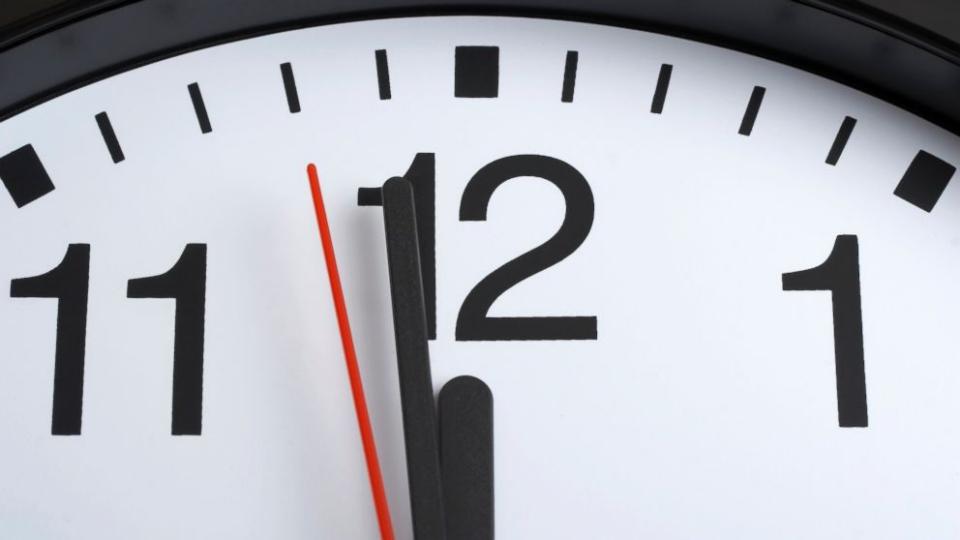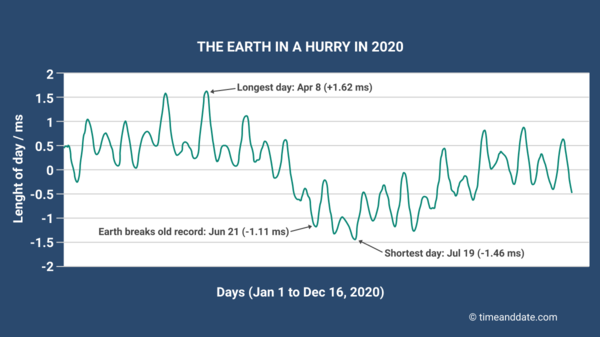

The last leap second was added on December 31, 2016, just before midnight UTC.
The International Earth Rotation and Reference Systems Service announced in July 2020 that there’d be no leap second added to the world’s official timekeeping in December 2020. The last leap second was December 31, 2016. Since leap seconds are always added on the last day of June or December, the next possible date for a leap second is June 30, 2021.
Leap seconds have been added 27 times since 1972. There were leap seconds added on June 30, 2015, and on June 30, 2012. They’re always added to the world’s clocks at 23 hours, 59 minutes and 59 seconds Coordinated Universal Time (UTC), on either June 30 or December 31.
The extra second is added to our official timekeeping mainly to keep our increasingly electronic world in sync.

Image via NASA.
Why do we need a leap second? Isn’t the length of our day set by the rotation of the Earth? Like the ancients who insisted that all motion in the heavens must be perfect, uniform and unvarying, many of us today assume that the Earth’s rotation – its spin on its axis – is perfectly steady. We learned, correctly, that the sun, moon, stars and planets parade across our sky because the Earth turns. So it is easy to understand why we assume that the Earth’s rotation is precise and unwavering. Yet Earth’s rotation does not stay perfectly steady.
Instead, compared to modern timekeeping methods such as atomic clocks, the Earth is a notoriously poor timepiece. Overall, as many know, Earth’s spin slowing down. The length of our day is increasing. The Wikipedia entry on this subject explains it well:
Earth’s rotation is slowing slightly with time; thus, a day was shorter in the past. This is due to the tidal effects the moon has on Earth’s rotation. Atomic clocks show that a modern-day is longer by about 1.7 milliseconds than a century ago, slowly increasing the rate at which UTC is adjusted by leap seconds. Analysis of historical astronomical records shows a slowing trend; the length of a day increased about 2.3 milliseconds per century since the 8th century BCE.
Earth’s rotation is slowing, but it can also speed up. The slowing is an overall trend. The speedup is more of a day-to-day phenomenon. TimeandDate has a very interesting article on a slight speed-up in Earth’s rotation in 2020.
The fact is, Earth’s rotation is subject to effects that cannot be predicted well. Other short term and unpredictable changes can be caused by a variety of events, ranging from slight changes in the distribution of mass in the Earth’s molten outer core, to movement of large masses of ice near the poles, and even density and angular momentum variations in the Earth’s atmosphere.
For example, you might recall the devastating Fukushima earthquake that struck in northeastern Japan in 2011. It was a magnitude-9.0 quake, the largest ever recorded in Japan, and it was the world’s fourth-biggest earthquake since 1900. It unleashed a powerful tsunami that caused the deaths of some 16,000 people and caused a nuclear meltdown at Fukushima Daiichi Nuclear Power Plant. It also caused displacements of portions of the Earth’s crust that sped up Earth’s rotation, shortening the day by 1.6 millionth of a second.

Variation of daylength throughout 2020. The length of day is shown as the difference in milliseconds between the Earth’s rotation and 86,400 seconds. Image via the article “Earth Is in a Hurry in 2020” at TimeandDate.com.
The cause of Earth’s slowing spin is well understood. If you have ever been to the beach, you will be familiar with the main reason our planet is slowing down. That reason is ocean tides. As our planet rotates, it plows past the great watery bulges (raised mostly by the gravitational interaction of the Earth and moon), which serves to slow it down much like a brake on a rotating wheel. This effect is small, actually very small. According to calculations based on the timing of ancient astronomical events (eclipses), the Earth’s rotation has slowed down by about .0015 to .002 seconds per day per century.
The Earth is slowing down, very slowly. It takes about 100 years for Earth’s rotation to add just 0.002 seconds to the time it takes Earth to spin once on its axis. What happens, though, is that the daily 0.002-second difference between the original definition of a day (86,400 seconds) builds up.
After one day is it 0.002 seconds. After two days it is 0.004 seconds. After three days it is 0.006 seconds and so on. After about a year and a half, the difference mounts to about 1 second. It is this difference that has prompted the addition of a leap second.
All of this is tracked, nowadays, to an extremely high precision by atomic clocks (which are accurate to about a billionth of a second per day).
And of course the slowdown is not constant either. According to the U.S. Naval Observatory, from 1973 to 2008, the variation in Earth’s spin has ranged from plus 4 milliseconds to minus 1 millisecond. Over time, that could necessitate a negative leap second, signifying an increase in the Earth’s rotation speed.
But, since the concept of leap seconds was introduced in 1973, this has never been done.
And, by the way, if this fine detail on timekeeping seem esoteric or unimportant to you, realize that it’s not to the telecommunications industry.

Modern telecommunications relies on precise timing, and the addition of a leap second forces many systems to be turned off for a second every year or two. That’s why there’s sometimes discussions about abolishing leap seconds. Image via aie195.com.
Not everyone thinks a leap second is a good idea. The International Telecommunications Union (ITU), a United Nations body that governs some global issues related to time, has been contemplating leap seconds for some time. They considered abolishing the practice, but in November 2015 – with delegates from more than 150 nations meeting in Geneva – the ITU announced it had decided not to dump the leap second, at least not right now. The ITU said:
The decision … calls for further studies regarding current and potential future reference time-scales, including their impact and applications. A report will be considered by the World Radiocommunication Conference in 2023.
So they’re still thinking about it.
Consider the ITU’s situation. Telecommunications relies on precise timing, and the addition of a leap second forces many systems to be turned off for a second every year or two. To get all such systems in a global industry cycled on and off in sync can be a major headache. Consider also that the global positioning system (GPS) does not use the leap second system, which causes further confusion. Many in the industry feel that the periodic addition of a leap second to keep the to measurements in step is cumbersome and wasteful.
Although dropping the idea of a leap second would be a convenience for telecommunication and other industries, in the long (very long) run, it would cause clocks to get out of synch with the sun, eventually causing 12 p.m. (noon) to occur in the middle of the night, for example. At the current rate of change in Earth’s rotation rate, it would take about 5,000 years to amass just a one-hour difference between the Earth’s actual rotation rate and the atomic clock.
How, you may ask, do we even measure such small changes in the Earth’s rotation? Historically, astronomers (such as those at Britain’s famed Royal Greenwich Observatory near London) have used a telescope to watch a star pass through their eyepiece, crossing an imaginary line called the meridian. Then they time how long it takes for the Earth to bring that around star back around to cross the meridian again. This is highly accurate for everyday purposes, but for scientific use it is limited in accuracy because of the wavelengths used and the murkiness of the atmosphere.
A much more accurate method is to use two or more radio telescopes separated by thousands of miles, in a technique called Very Long Baseline Interferometry. By carefully combining the data from each of the telescopes, astronomers effectively have a telescope thousands of miles in size, which provides much greater resolution (detecting fine detail) and measurement of position. This allows them to determine the planet’s rotation rate to an accuracy of less than a thousandth of a second. They do not observe stars, however, but very distant objects called quasars. The NASA video below will tell you more …
[youtube https://www.youtube.com/watch?v=59Bl8cjNg-Y&w=800&h=450]Bottom line: A leap second will not be added to official timekeeping on December 31, 2020. World timekeepers will consider a proposal to dump the leap second in 2023. Stay tuned, timekeepers!
Read more from PhysicsWorld: A brief history of timekeeping
Source:
https://earthsky.org/human-world/leap-second-june-30-december-31-why-need-controversy